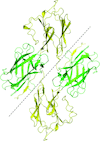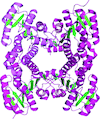issue contents
February 2021 issue

Cover illustration: The adhesin SdrC from Staphylococcus aureus [Wang et al. (2021), Acta Cryst. F77, 47-53]. S. aureus is an opportunistic pathogen that can trigger severe diseases such as sepsis, endocarditis and toxic shock. Bacterial aggregation and biofilm accumulation are important in the progression of disease, and SdrC, an S. aureus surface protein, can act as an adhesin to promote cell attachment and aggregation by an unknown mechanism. Here, structural studies demonstrate that SdrC forms a unique dimer and this is proposed to enhance the efficiency of bacteria-host attachment and therefore contribute to the pathogenicity of S. aureus.
research communications
In this study, biochemical and mass-spectrometric experiments, as well as features of the Phenix software package, were used to determine which residues to model into a segment of electron density of unknown origin.
Staphylococcus aureus SdrC forms a unique dimer through homophilic interactions, and a sandwich-like clamp at the C-terminus is formed by the two monomers in the stabilized SdrC dimer. Comparison with other Sdr proteins led to the proposal of a model for the confomational change of SdrC upon ligand binding.
The structure of acetoacetyl-CoA reductase from Rickettsia felis, the causative agent of flea-borne spotted fever, is reported. Acetoacetyl-CoA reductase is a key enzyme in both the glyoxylate/dicarboxylate and butanoate metabolic pathways.



 journal menu
journal menu















![[publBio]](/logos/publbio.gif)





